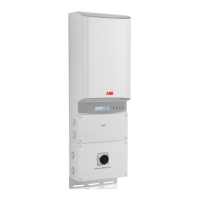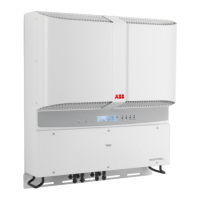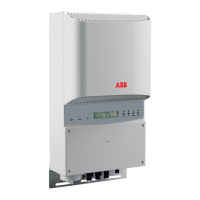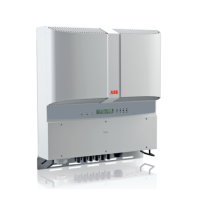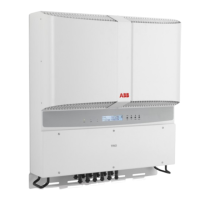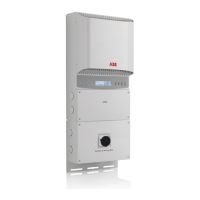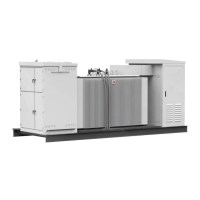Do you have a question about the ABB PVI-5000-TL-OUTD and is the answer not in the manual?
Warranty conditions are valid if manual indications are followed; deviating conditions require express agreement.
Manual explains safe operation and identifies target users. Original language is Italian.
Operators must be skilled, trained, and use PPE. Customer liable for staff qualifications.
Explains danger/hazard symbols used in the manual and on the equipment for safety.
Details allowed use, field limits, and strictly forbidden operations to ensure safety.
Details available inverter models (PVI-5000/6000-TL-OUTD/S) by power and features.
Comprehensive table of electrical and physical characteristics for PVI-5000 and PVI-6000 models.
Presents efficiency curves and explains power derating due to environmental conditions and input voltage.
Covers equipment description, operating diagram, connecting multiple inverters, and key functionalities.
Details essential safety devices like Anti-Islanding, ground fault protection, and overvoltage surge arresters.
Crucial safety guidelines for installation and maintenance; manual adherence is mandatory.
Covers general safety principles, manufacturer liability, and operator training requirements.
Addresses environmental risks, hazardous areas, and proper handling of signs and labels for safety.
Details thermal hazards, required PPE, and residual risks with mitigation strategies.
Covers safe transport, handling, lifting, and unpacking of the inverter and its components.
Detailed list of all parts included with the inverter for installation purposes.
Specifies the inverter's weight and the number of lifting points for safe manual handling.
Covers environmental checks, high altitude considerations, and optimal installation positioning.
Step-by-step guide for securely mounting the inverter bracket on walls or poles.
Critical pre-connection checks: polarity, ground leakage, and differential protection selection.
Details configuring MPPT channels (independent/parallel) and connecting PV strings to the DC input.
Covers AC connection requirements, line cable sizing, load protection switch, and terminal board connection.
Explains RS485 serial communication, connecting to monitoring systems, and remote control/alarm relay connections.
Describes the function of the keyboard keys (ESC, UP, DOWN, ENTER) and the status indicated by LEDs.
Inverter operates automatically, with status indicated by LEDs and LCD; data accessible via RS-485.
Steps for initial startup, nation selection, grid connection checks, and LED status interpretation.
Accesses settings via password to configure address, display, nation, language, and operational parameters.
Details alarm relay configuration, remote control options, and UV protection time settings.
Manages reactive power feed-in and limits active power output based on grid standards or user settings.
Guides on performing automated tests for grid compliance (OV, UV, OF, UF) from the display menu.
Scheduled checks for inverter operation, labels, cables, environmental conditions, and cleaning.
Guides on identifying and resolving warning (Wxxx) and error (Exxx) messages using the display and provided solutions.
Explains messages indicating power limitations due to user settings, grid standards, or internal protections.
Procedure for obtaining service passwords, resetting grid standard timers, and replacing the buffer battery.
Details verification of ground leakage, behavior with/without leakage, and measuring insulation resistance.
Provides guidance on storing the equipment, dismantling, and responsible disposal of components.
Warranty conditions are valid if manual indications are followed; deviating conditions require express agreement.
Manual explains safe operation and identifies target users. Original language is Italian.
Operators must be skilled, trained, and use PPE. Customer liable for staff qualifications.
Explains danger/hazard symbols used in the manual and on the equipment for safety.
Details allowed use, field limits, and strictly forbidden operations to ensure safety.
Details available inverter models (PVI-5000/6000-TL-OUTD/S) by power and features.
Comprehensive table of electrical and physical characteristics for PVI-5000 and PVI-6000 models.
Presents efficiency curves and explains power derating due to environmental conditions and input voltage.
Covers equipment description, operating diagram, connecting multiple inverters, and key functionalities.
Details essential safety devices like Anti-Islanding, ground fault protection, and overvoltage surge arresters.
Crucial safety guidelines for installation and maintenance; manual adherence is mandatory.
Covers general safety principles, manufacturer liability, and operator training requirements.
Addresses environmental risks, hazardous areas, and proper handling of signs and labels for safety.
Details thermal hazards, required PPE, and residual risks with mitigation strategies.
Covers safe transport, handling, lifting, and unpacking of the inverter and its components.
Detailed list of all parts included with the inverter for installation purposes.
Specifies the inverter's weight and the number of lifting points for safe manual handling.
Covers environmental checks, high altitude considerations, and optimal installation positioning.
Step-by-step guide for securely mounting the inverter bracket on walls or poles.
Critical pre-connection checks: polarity, ground leakage, and differential protection selection.
Details configuring MPPT channels (independent/parallel) and connecting PV strings to the DC input.
Covers AC connection requirements, line cable sizing, load protection switch, and terminal board connection.
Explains RS485 serial communication, connecting to monitoring systems, and remote control/alarm relay connections.
Describes the function of the keyboard keys (ESC, UP, DOWN, ENTER) and the status indicated by LEDs.
Inverter operates automatically, with status indicated by LEDs and LCD; data accessible via RS-485.
Steps for initial startup, nation selection, grid connection checks, and LED status interpretation.
Accesses settings via password to configure address, display, nation, language, and operational parameters.
Details alarm relay configuration, remote control options, and UV protection time settings.
Manages reactive power feed-in and limits active power output based on grid standards or user settings.
Guides on performing automated tests for grid compliance (OV, UV, OF, UF) from the display menu.
Scheduled checks for inverter operation, labels, cables, environmental conditions, and cleaning.
Guides on identifying and resolving warning (Wxxx) and error (Exxx) messages using the display and provided solutions.
Explains messages indicating power limitations due to user settings, grid standards, or internal protections.
Procedure for obtaining service passwords, resetting grid standard timers, and replacing the buffer battery.
Details verification of ground leakage, behavior with/without leakage, and measuring insulation resistance.
Provides guidance on storing the equipment, dismantling, and responsible disposal of components.
